John 5:24
"Home is the Sailor, Home From The Sea.... And The Hunter, Home From The Hill"

 Permission Granted To Come Aboard...
Permission Granted To Come Aboard...
..And Welcome To The Pirate's Lair!
a Division of DataCity, Inc.
Click Here and Return to The Pirate's Lair Home Page www.thepirateslair.com

Enlisted Seaman's Naval Cutlass, Boarding Axes and Boarding Pikes Made For Sea Service From Early 1700's Thru Early 1900's British Royal Navy, Netherlands or Royal Dutch Navy, French Navy, American Colonial and US Navy - Photo-Historical Documentation, Technical Information, Price and Availability
(Anterbil, Enterbeil, Enterhaken, Entermesser, Entrebil or Hache Du Bord)
Call The Pirate's Lair @ 540-659-6209

Custom Wooden Wall Brackets for the Naval Cutlass
Elegant in Their Simplicity! Custom Crafted Wooden Wall Brackets Made Specifically for a Cutlass Display or Large Hilted Sword Display for a Secure, Beautiful and Professional Presentation.
These Handcrafted Wooden Wall Brackets or Wall Mounts Are Made for the Wide and Large Hilts Normally Found on Cutlasses and Some Swords and Prevent the Hilt or Cup From Touching the Wall. The TPL Wall Brackets Come Complete with 2 Brackets and 2 Mounting Screws, and are Available in 3 Sizes with a Choice of Oak or Walnut Woods! |
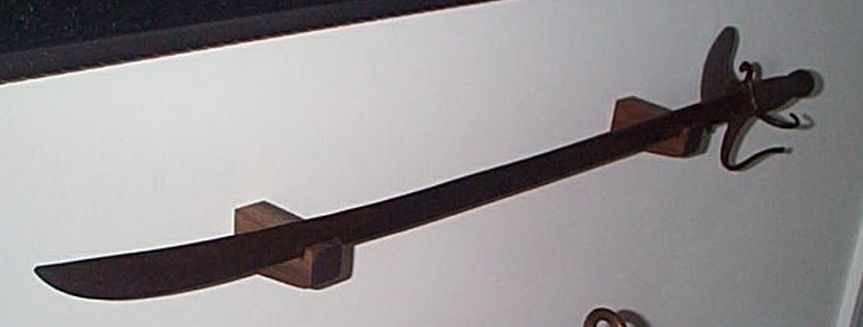
Click Photo |
$35. Pair
2.25" 2.75" 3.75"
specify length and either Oak or Walnut when calling. |
Call To Purchase
540 659 6209 |
 European Contract Naval Cutlass for Naval and Maritime issue by 17th and 18th Century British and Dutch East India Companies, Colonialists, Privateers, Pirates and Naval Seaman - Yes, Pirates!
European Contract Naval Cutlass for Naval and Maritime issue by 17th and 18th Century British and Dutch East India Companies, Colonialists, Privateers, Pirates and Naval Seaman - Yes, Pirates!
|
 Continue on this Page for American Revolutionary War Colonial, Federal Navy and US Navy Period Cutlasses, Boarding Axes and Boarding Pikes: 1750's-1796 American Revolution, 1797 Pattern, 1800 "Baltimore" Pattern, M1808 Starr, M1816 Starr, M1826 Starr, M1841 Ames, Confederate Navy Courtney & Tennant by Mole, M1860 Ames, M1917 US Navy, M1941
Continue on this Page for American Revolutionary War Colonial, Federal Navy and US Navy Period Cutlasses, Boarding Axes and Boarding Pikes: 1750's-1796 American Revolution, 1797 Pattern, 1800 "Baltimore" Pattern, M1808 Starr, M1816 Starr, M1826 Starr, M1841 Ames, Confederate Navy Courtney & Tennant by Mole, M1860 Ames, M1917 US Navy, M1941
|
 The British Privateer and Royal Navy Naval Boarding Pikes, Boarding Axes, and Cutlass Patterns 1750-1796, 1804, 1845, 1889, 1901. For historical display are American-captured British Royal Navy P1804 cutlasses!!
The British Privateer and Royal Navy Naval Boarding Pikes, Boarding Axes, and Cutlass Patterns 1750-1796, 1804, 1845, 1889, 1901. For historical display are American-captured British Royal Navy P1804 cutlasses!!
Click Here For British Royal Navy Weapons for Sea Service - the Naval Cutlass, Boarding Pikes and Boarding Axes.
|
 Cutlasses and Boarding Axes! The French Naval AN IX 1801 and M1833 Cutlass Models, Early 19th Century Infantry Briquet, and Foot Artillery Short Sword M1831
Cutlasses and Boarding Axes! The French Naval AN IX 1801 and M1833 Cutlass Models, Early 19th Century Infantry Briquet, and Foot Artillery Short Sword M1831
Click Here For French Navy 18th/19th Century Naval Cutlasses and and Boarding Axes
|
 The Dutch-Netherlands Klewang Cutlass and WWII "Heiho" Models M1898, M1911, M1941
The Dutch-Netherlands Klewang Cutlass and WWII "Heiho" Models M1898, M1911, M1941
Click Here For Netherlands or Dutch Navy 19th/20th Century Naval Cutlass Klewangs
|
 Scandinavian, Danish, Swedish Naval Cutlasses and Boarding Axes
Scandinavian, Danish, Swedish Naval Cutlasses and Boarding Axes
Click Here For Scandinavian and Swedish Naval Cutlass and Boarding Ax
|
Or Click Here for Naval Boarding Axes, Boarding Pikes, and Other Edged Naval Weapons
Click Here for Civil War and War of 1812 Naval Items - Navy Bayonets, Navy Buttons, Seamans Ditty Boxes, Navy Fuse Pouches, etc, etc
Here's the Sea Service Cutlass Crew!
Not Pretty Yet Handsomely Elegant and Honest in Their Function!

1650's-1750's Above Photograph Illustrates a mid-late 17th or early 18th Century British-made Hunting Cutlass or Naval Cutlass with all brass hilt. Well documented and used mostly by Naval Officers as personal side arms as well as Privateers and Pirates! Yes, Pirates. Well documented in the authoritive "Boarders Away" reference guide. The maker mark on the side of the blade reads HARVEY which was a well-known British Cutler in the family tradition of making swords and cutlasses from the 17th thru 19th centuries.
Click Here for further more indepth Technical Characteritics, Price, and Information on this specific American Revolutionary War naval cutlass

1650's-early 1800's Above Photograph Illustrates a classic 17th to early 19th Century Spanish Colonial Espada Ancha Cutlass or Broad Sword from a re-worked Spanish produced Armada/Conquistodore blade and "New World" handforged leather wrapped iron hilt. Blade has some very detailed "mystical symbols" popular during the 16th and 17th centuries on blades produced in Europe and in Spain.
Click Here for further more indepth Technical Characteritics, Price, and Information on this specific 17th-18th century Colonial American cutlass or sword.

1600's-early 1700's Above Photograph Illustrates a Solingen marked Iron Hilted contract naval cutlass stamped and made by Solingen with a Running Wolf and mystical symbols on both sides of the 25" straight single fullered blade. This model contract cutlass was found to be Naval-issued as a Sea Service weapon by Governments, Privateers, the British and Dutch East India Companies, Colonial Merchantmen, and the cutlass preferred by Pirates!
Click Here for further more indepth Technical Characteritics, Price, and Information on this and other Pre-American Revolutionary War Naval Cutlasses

1680's-1750's Above Photograph Illustrates a pre-Revolutionary War European contract naval cutlass made by Passau (Germany) dated 1745 with a Running Fox or Wolf. This standard model contract cutlass was found to be Naval-issued as a Sea Service weapon by Privateers, the British and Dutch East India Companies, Colonial Merchantmen, and the cutlass preferred by Pirates!
Click Here for further more indepth Technical Characteritics, Price, and Information on this and other Pre-American Revolutionary War Naval Cutlasses

1750's-1770's French Indian War time period. Above Photograph Illustrates a pre-Revolutionary War British Royal Navy or Colonial American produced naval cutlass with an iron grip and ox bone handle, and triple fullered curved blade, no markings. This exact type of naval cutlass was first produced and documented by a British Cutler named "Hollier" in the early to mid 1700's certainly during the French and Indian War and into the American Revolution era.
However it is unclear however whether this was a British-made or American Colonial-made naval cutlass for the American Colonial Navy, but we are leaning towards American Colonial manufactured due to the crudity of the guard and ox bone handle. British workmanship was far superior at the time to American colonial workmanship. Since there is a fair amount of pitting on both blade and iron grip not having markings cannot be considered in determining provenance as they could have been erased over time.
Click Here for further more indepth Technical Characteritics, Price, and Information on this and other Pre-American Revolutionary War Naval Cutlasses

1750's-1770's Above Photograph Illustrates a pre-Revolutionary War British or Colonial American produced naval cutlass with a figure 8 iron grip and bone handle, and double fullered curved blade, no markings. This exact type of naval cutlass was first produced and documented by a British Cutler named "Hollier" in the early to mid 1700's certainly during the French and Indian War and into the American Revolution era.
It is unclear however whether this was a British-made or American Colonial-made naval cutlass, but we are leaning towards American Colonial manufactured due to the crudity of the figure 8 guard. British workmanship was far superior at the time to American colonial workmanship. Since there is a fair amount of pitting on both blade and iron grip not having markings cannot be considered in determining provenance as they could have been erased over time.
Click Here for further more indepth Technical Characteritics, Price, and Information on this and other Pre-American Revolutionary War Naval Cutlasses

1750's-1770's Above Photograph Illustrates a re-worked and re-bladed British Infantry 1750 Pattern Regulation hilt with a colonial produced unmarked flat upturned falchion blade. Note the heart shaped guard with the reverse side filed smooth so as to provide a better fit against the hip when being worn thru a belt. This type of re-worked hilt was relatively common by American seaman to provide a better more personalized fit. Note also that the securing ball of the pommel was professionally removed and then re-attached so that the hilt and blade are tight. However this was not the case in either the British Army or Navy where there was no customization was allowed and strictly forbidden.
An example of this type of re-working of the hilt can be found in the authoritive "Boarders Away" reference guide by William Gilkerson.
Click Here for further more indepth Technical Characteritics, Price, and Information on this specific cutlass.

1770's-1790's Above Photograph Illustrates a pre-1804 British Royal Navy marked "double disk" or figure-8 naval cutlass with round sheet metal grip and single fullered very slightly curved blade, a pattern commonly found in the mid to late 18th century (1770-1790s) used by both British and American navies as documented in the authoritive "Boarders Away" reference guide. This double disk figure 8 style and configuration may have been produced in England for the Royal Navy as early as the early 1700s.
Click Here for further more indepth Technical Characteritics, Price, and Information on this specific British Royal Navy Cutlass used during the American Revolutionary War

1770's-1790's Above Photograph Illustrates a pre-1804 American Navy "double disk" or figure-8 naval cutlass with round sheet metal grip and single fullered straight blade another pattern commonly found in the mid to late 18th century (1770-1790s). This particular figure 8 cutlass has been determined to be of American manufacture due to the crudeness in its manufacture (as opposed to British made which was more refined by the Kings cutlers). Again this has been well documented in the authoritive "Boarders Away" reference guide. Additionally, this particular cutlass was found in a collection just outside of Portsmouth, England and most likely captured and brought home by some English seaman.
Click Here for further more indepth Technical Characteritics, Price, and Information on this specific American Produced Cutlass used during theRevolutionary War


1804-1816 - Above Photographs Illustrate Two Identical Most Likely American-made Copies of the Standard British Royal Navy Sea Service 1804 Pattern Cutlass. Also called a "Private Purchase" cutlass as it was used aboard Privateers with Letters of Marque and Armed Merchantmen during the Napoleonic Wars, Barbary Pirate Wars, and War of 1812.
However one of these cutlasses was found in the UK while the other here in America.
Click Here for further more indepth Technical Characteritics, Price, and Information on these Two Private Purchase Naval Cutlasses

1799-1808 - Above Photograph Illustrates the American Federal Navy's Baltimore Pattern Cutlass which certainly saw service during the Barbary Pirate Wars and in War of 1812. While this particular cutlass has been known as the "Baltimore" model because a number of them were found in Baltimore, it is now believed that they were in fact produced in Philidelphia. However since no firm provenance can be established they are still referred to as the "Baltimore". Rare, only few are known to exist!
This cutlass pattern is identified and discussed thoroughly in Gilkerson's "Boarders Away" reference book.
Click Here for further more indepth Technical Characteritics, Price, and Information on the US Navy's ca 1800 "Baltimore Pattern" Naval Cutlass

1808-1816 - Above Photograph Illustrates the American Navy's Model M1808 Naval Cutlass by Nathan Starr (also known as the "1808 Starr Contract" which was used during the War of 1812 and the Barbary Pirate War from 1808 through 1816, and only 1,000 were manufactured according to the contract. The M1808 is known as "the cutlass that fought the War of 1812".
Click Here for further more indepth Technical Characteritics, Price, and Information on the US Navy's Model M1808 Nathan Starr contract Naval Cutlass

1816-1825 - Above Photograph Illustrates the US Navy's Model M1816 Naval Cutlass by Nathan Starr (also known as the "1816 Starr Contract" which was used during the latter part of the War of 1812 and the Barbary Pirate War from 1816 through 1826, and only 1,000 were manufactured according to the contract. This model cutlass is very similar to the prior M1808 contract with the only exception being the flared edges of the cup guard, slight bulge in the middle of the turned maple grip, and the stamped "N STARR, US, and Eagle" located on the ricasso of the shorter 25.75" blade.
Click Here for further more indepth Technical Characteritics, Price, and Information on the US Navy's Model M1808 Nathan Starr contract Naval Cutlass

1826-1840 - Above Photograph Illustrates the US Navy's Model M1826 Naval Cutlass by Nathan Starr which was used in relative peacetime from 1826 through 1840, and only 2,000 were manufactured for the Navy according to the contract.
Click Here for further more indepth Technical Characteritics, Price, and Information on the US Navy's Model M1826 Nathan Starr contract Naval Cutlass

1841-1847 - Above photos show the short-lived US Navy Model M1841 naval cutlass which saw service during the Mexican War and start of the Civil War.
Click Here for further more indepth Technical Characteritics, Information, Pricing and Delivery on the US Navy's M1841 Naval Cutlass

1860s-1890s - Above Photograph Illustrates two of the US Navy's Wooden Practice Cutlass used in "single stick" training sessions typically aboard ship. Made of handcarved one-piece oak poles with leather cups to protect the hand and fingers, held in place by a screw and washer at the pommel end and a sharp wooden dowel at the front or guard. Not many of these "single stick" practice cutlasses survived due to the very nature of their use!
See Civil and SpanAm War 1861-1899 period photos of sailors during single stick cutlass drill.
Click Here to Review more Photographic History, Period Photos, Technical Characteristics, Pricing and Availability Regarding the US Navy's Single Stick Practice Cutlass

1860s - Above Photograph Illustrates one of ONLY two confirmed models of Confederate States Navy Cutlass! Both CSN cutlass models were manufactured in England by "Mole & Sons of Birmingham, England" and imported into the Confederacy by "Courtney & Tennent, Charleston, SC". The CSN model cutlass shown above (and in The Pirates Lair Collection) has the open brass hilt with a knuckle guard and one branch with the top branch missing from potentially battle damage. The second model also by Mole has a closed brass cup similar to the Unions M1860 below.
Both models were marked "MOLE" along the top edge of the blades ricasso and also stamped "Courtney & Tennent, Charleston SC" in a box on the blades ricasso.
Click Here to Review more Photographs and Technical Characteristics Regarding the Confederate States Navy CSN Naval Cutlass.
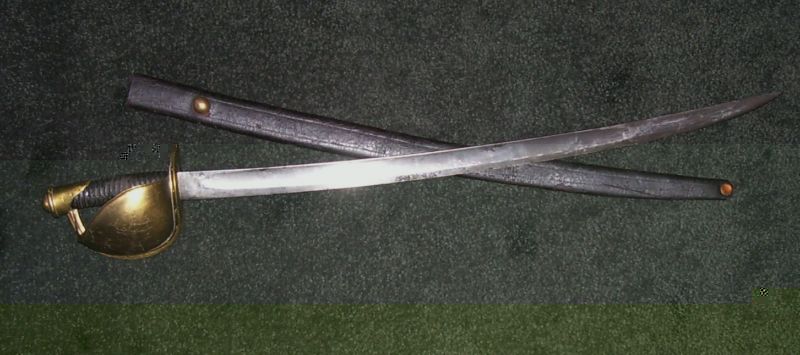
1861-1941 - Above Photograph Illustrates the US Navy's Model M1860 Cutlass and Scabbard Produced and Saw Service During the American Civil War 1861-1865, Chinese Boxer Rebellion, Spanish American War 1898, First and Second World Wars. This was by far the most popular cutlass ever used by the US Navy with well over 25,000 produced with a 70+ year service life.
Click Here to Review more Photographic History, Technical Characteristics, Pricing and Availability Regarding the US Navy's Model M1860 Naval Cutlass

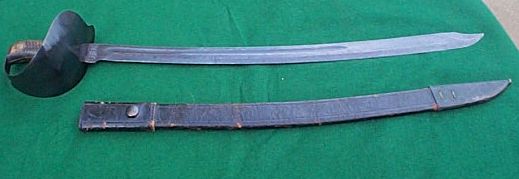
1917-1941 - The above two photos show the US Navy's Model M1917 Naval Cutlass with its attending scabbard. Note the dark blueing on the blade. The hilt's closed steel cup and knuckle guard appears very similar to the previous M1860 naval cutlass. The closed cup is also the major difference between the Navy's M1917 cutlass and the Dutch Klewang M1898 cutlass from which it was patterned after.
As we proceed notice the clipped point on the M1917, it is exactly the same as the Dutch Klewang.
Click Here for indepth Photographic Documentation, Technical characteristcs and Pricing and Availability for the US Navy's model M1917 Naval Cutlass

1941-1948 - Above photograph shows the "ubiquitous" U.S. Navy M1941 Naval Cutlass produced by Milsco (Milwaukee Saddlery Company). Notice how the cup is open like the Dutch-made Klewang, but the blade is essentially just like the U.S. Navy M1917 cutlass as well as the Dutch M1898. Milsco and another U.S. company called Vince both produced blades and complete cutlasses for the Dutch government just prior to WWII, up until when the Netherlands was occupied by the Germans in 1941.
Click Here for indepth Photographic Documentation, Technical characteristcs and Pricing and Availability for the Dutch Klewang and sometimes known US Navy M1941 Naval Cutlass
Below The Reader Will Find Photo-Historical Documentation and Links Regarding the Above American, French, British, and Dutch Navy Cutlasses!

Above photos show the short-lived US Navy Model M1841 naval cutlass which saw service during the Mexican War and start of the Civil War.
Click Here for further more indepth Technical Characteritics, Information, Pricing and Delivery on the US Navy's M1841 Naval Cutlass
This particular naval cutlass was designed around the US Army's Model M1832 Foot Artillery Short Sword (see below left) which itself was derived from the French Foot Artillery Sword Model 1816 (see below right). The enlisted sailors found this M1841 cutlass to be heavy, unbalanced, and particularly unwieldly when used aboard a ship at sea, and it was never a popular weapon.
The M1841 design of naval cutlass was certainly a big departure from all past cutlasses used by the U.S. or any other navy. As such this was a very limited production naval cutlass model with only 6600 being produced for the US Navy over a 5 to 6 year period, making them relatively rare.
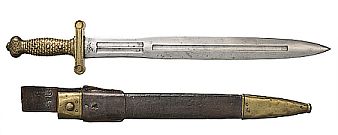

To the left is a US Artillery Sword Model M1832 which the Naval M1841 was designed from. To the right shows the French Model 1816 Foot Artillery Sword from which the US M1832 Foot Artillery Sword was derived from. It is generally believed and accepted that all swords with this pattern of hilt and double blade were originally patterned after the neo-classical Roman "Gladius".
The similarities between the M1832 artillery sword and M1841 naval cutlass had a brass fish scale hilt, eagle insignia on the pommel, and double edged blade with a full length medial-rib down the middle. The major distinctive differences between these models were the 3 stopped fullers found on the blade of the M1832 whereas the naval blade was smooth with no fullers; the naval cutlass had a closed knuckle guard and cup (or D Guard), whereas the M1832 sword only had a cross guard.
The scabbard for the M1841 was of leather with brass rivets running down the seam very similar to the scabbard of the M1860 naval cutlass described below.
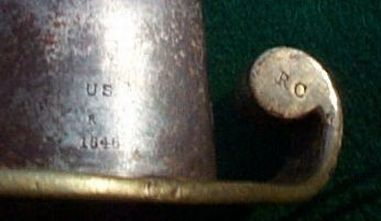
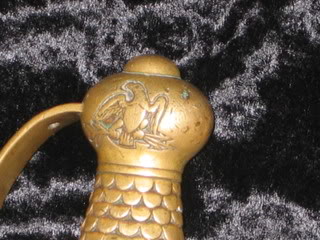
Above two photographs show the U.S. Navy's M1841 Naval Cutlass.
The M1841 Naval Cutlass was 26.5" overall length with a 21" dual edge straight blade similar to a Roman Legionaires "Gladius" short sword. With an all brass hilt and grip resembling fish scales or feathers with a D-style knuckleguard and cup. The reverse and obverse sides of the pommel had the Federal Eaglee. Sometimes either the cup or guard on the hilt had both numbers and letters stamped onto them post-production.
These numbers and letters were used to designate the rack number where the cutlass was stored aboard the particular ship it was on. Sometimes you will see more than one set of stamps if the cutlass served aboard more than one naval vessel.
The M1841 was manufactured by Ames Manufacturing Company and was maker marked with a stamp on the obverse ricasso in 3 lines: N.P. Ames, Cabotville, Mass or N.P. Ames, Springfield, Mass. When Ames first began producing this weapon for the US Navy the initial production facility was in Cabotville.
Additional manufacturing marks will also be found on the reverse side of the ricasso and these are sometimes varied but usually consist of a either the intials U.S. or U.S.N, the actual date of manufacturer, typically between 1842 thru 1846, and most times there will also be an ordinance inspector's initials. I the case of the above cutlass it was marked U.S., dated 1846, and the ordinance inspection stamp "R" is found below the initials USN and above the date, 1846.
The U.S. Naval Cutlass model M1841 will also have two more inspector's marks found on the quillion atop the guard and these initials will be "JL" on the obverse and "RC" on the reverse.
Unfortunately we have yet to find any "period" photographs showing the M1841 being used or stored. We can only attribute this to the lack of photographic technology being available at the time the M1841 was in production. Photography became of age and regularly used in the late 1850's and certainly by the time the Civil War broke out in 1861.
Once the newer model of naval cutlass (model M1860) was introduced it stands to reason that the dreaded M1841 was put aside in favor of this newer more modern and wieldly cutlass.
This ends the brief discussion and about the US Navy's Model M1841 Naval Cutlass,
Click Here for further more indepth Technical Characteritics, Information, Pricing and Delivery on the US Navy's M1841 Naval Cutlass
Below we will move onto the U.S. Navy's hallmark cutlass, the M1860 naval cutlass. This naval cutlass was a mainstay in the Navy's inventory for 80 years and was found throughout the Civil War, Spanish-American War, Boxer Rebellion, WWI and even up till WWII.


Photos above show the US Navy's M1860 naval cutlass.


Photos above show the French naval cutlass model M1833 which the US Navy's M1860 was patterned after.
Click Here For Price, Availability and Technical Information on the French Naval Cutlass M1803 and M1833.
Like the earlier M1841 naval cutlass which was modeled after a US Artillery Short Sword (and a French M1816 Infantry design), the US Navy's M1860 cutlass was modeled after the French M1833 naval cutlass design, which was the most popular navy cutlass throughout the world in the early to mid 19th century, and was copied by most every European military except for the British Royal Navy.
The M1860 cutlass was very popular among American enlisted sailors and it was used and part of the Navy's arsenal for or over 80 years. There were reports that the M1860 was even seen on WWII destroyers and listed as part of the inventory of personal weapons.
This was just a very elegant naval cutlass of which over 24,000 were made by the Ames Manufacturing Company of Chicopee, Mass between the years 1861 and 1865. The M1860 cutlass was well marked and there are rare period photographs which actually show this cutlass in use: how it was worn, who wore it, how it was stored.
Note the similarities between the M1860 and M1833 cutlass: Sweeping upturned falchion blade and large closed hilt. However the similarities ends there with the hilt of the U.S. cutlass being made of brass while the French model was made of iron and japanned black. The US grip was made of wood wrapped in shagreen leather with twisted brass wire, while the French model was iron sheathing.
Also the French model's blade was a bit longer and thicker than the U.S. model making it a bit more heavier. Using brass instead of the iron and reducing the size of the blade significantly reduced the weight of the U.S. model, and arguably made it a bit more wieldly for boarding and repelling boarders on pitching and heaving decks.
Click Here For Price, Availability and Technical Information on the French Naval Cutlass M1803 and M1833.
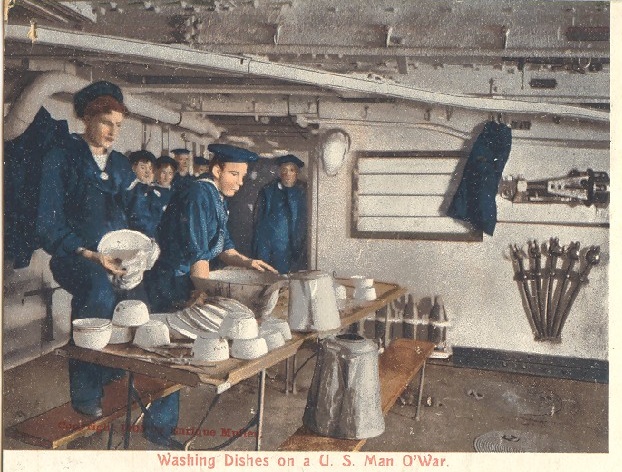
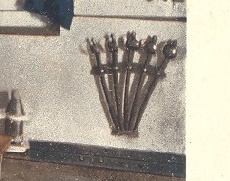
Photograph on left shows US Navy sailors washing enamelware plates and cups in a galley aboard an armored cruiser or battleship (caption states "Man O' War") which would make this photograph in the late 1880's to late 1890's.
Also the uniforms being worn by the sailors indicate post-civil war vintage, possibly during the 1898 Spanish American War or maybe even as late as the 1905 Great White Fleet era. There are anecdotal stories of this M1860 model of Naval Cutlass being used by the US Marines and Naval Infantry in China during the 1899-1901 Boxer Rebellion.
But note the 5 Civil War-era US Navy Model M1860 Naval Cutlass shown in a Storage Rack on the bulkhead of the galley.
This is one of the very few photographs of the M1860 Naval Cutlass actually being shown in actual use, and also documenting its ready availability to be used even into the very late 19th century or early 20th century.
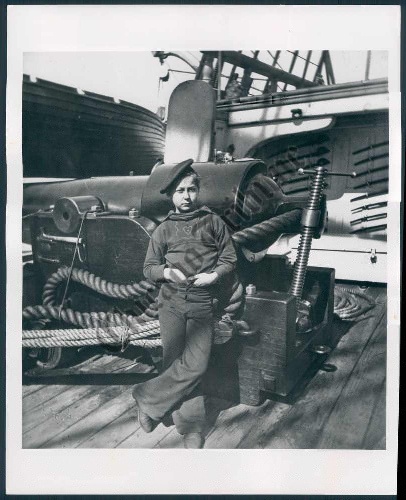
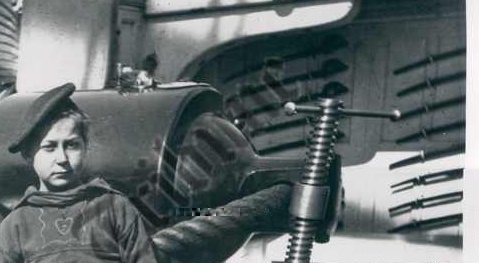
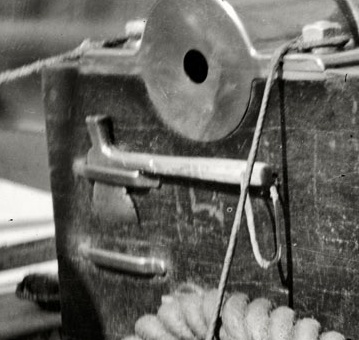 Click Here For Expanded Photographic View
Click Here For Expanded Photographic View
Another rare Civil War photograph onboard the USS New Hampshire during the seige of Charleston Harbor, SC ca 1865. Note the sheathed US Naval Cutlass Model M1860 being shown stored in an arms locker near the large deck gun, ready for use to board or repell a boarding. Appears that at least 16 and most likely 32 of these sheathed cutlasses are being stored and ready for use within this securable armament locker.
Note also the "Boarding Ax" stored safely against the cheek of the gun and ready for use! It was also a regulation to have at least one boarding ax at the ready for each gun position. In looking closely it appears that a second boarding ax could have been stored below the first as there is a bracket there to hold one.
By the ending days of the Civil War the boarding ax was practically in name-only as it became a staple everyday tool of every enlisted bluejacket aboard a steamer. The two notches located on the bottom of the blade was at this time just a darwinian throwback to the boarding axes of the past since they really did not have much use as boarding weapons. Note that instead of a thick sharp angled pike to remove hotshot the from decking of a ship,
this pike was now replaced with a hammer head.
The youngster in the photograph was called a "Powder Monkey" who was a boy barely in his teens assigned as crewmembers aboard US Navy warships whose job it was to carry gun powder from the magazine to cannons during time of battle as well as performing other ordinance duties on a warship. The usage of this term dating from about 1682 to as late as WWI, even though by that time the US Navy was no longer enlisting children as crewmembers.

Another photograph aboard the USS New Hampshire taken from a different angle with a more senior enlisted sailor. Note the armament locker and racked M1860 cutlasses in the background.
It has been well documented that the naval cutlass (as well as the boarding pike and boarding ax) were required to be "stored at the ready" both above and below decks near the canon or gun ports as well as in armament storage lockers to be used in offensive or defensive situations. The hardship was to find a place where these edged weapons could be safely stored and covered from the weather, but also easily handed out and gotten to in the event of a boarding situation. Here we have a perfect example of adhering to those regulations for both the boarding ax and cutlass.
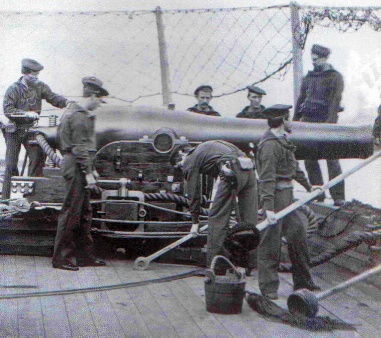
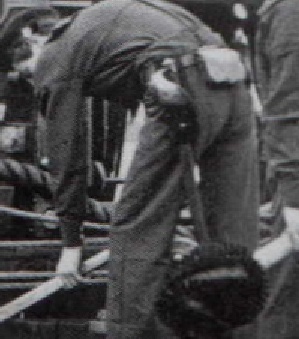
The above photograph and closeups clearly demonstrate that the gun crews aboard US Navy warships during the Civil War routinely wore the M1860 Cutlass during drills and live fire battles.
This rare photograph clearly shows how the naval cutlass was worn by enlisted sailors, see the left hip in the closeup photo. It appears that the Navy-regulation for the proper wearing of the M1860 naval cutlass was behind and over the left hip so that it could be easily and safely retrieved with the right hand grasping the cutlass grip and the left hand holding the scabbard. Upon much closer inspection it can be seen that at least 1 other and possibly 2 more bun crew sailors are wearing the M1860 Cutlass during this drill.
Note also the hanging net in the backdrop of the photograph which was hoisted up as part of the defense of the gun and its crew and was used to help repel boarders during engagement with enemy forces. This anti-boarding net put a potential enemy boarder into a very vulnerable position from gaining access to the deck by a defender using a myriad of offensive and defensive weapons including the cutlass, pistols, rifles and especially the pike!
Click Here to Review more Photographic History, Technical Characteristics, Pricing and Availability Regarding the US Navy's Model M1860 Naval Cutlass
Next we will look at both the U.S. Naval Cutlass Models M1917 and ubiquitous M1941 which replaced the M1860. Both the M1917 and M1941 were modeled after the Dutch Klewang cutlass M1898 and M1911. Yes folks, the US Navy again pirated the cutlass designs of another naval service. Fact is that the United States Navy never designed its' own cutlass from its first inception during the Revolutionary War through WWII at which time the naval cutlass was stricken from service as an authorized weapon.


The above two photos show the US Navy's Model M1917 Naval Cutlass with its attending scabbard. Note the dark blueing on the blade. The hilt's closed steel cup and knuckle guard appears very similar to the previous M1860 naval cutlass. The closed cup is also the major difference between the Navy's M1917 cutlass and the Dutch Klewang M1898 cutlass from which it was patterned after. As we proceed notice the clipped point on the M1917, it is exactly the same as the Dutch Klewang.
Click Here for indepth Photographic Documentation, Technical characteristcs and Pricing and Availability for the US Navy's model M1917 Naval Cutlass

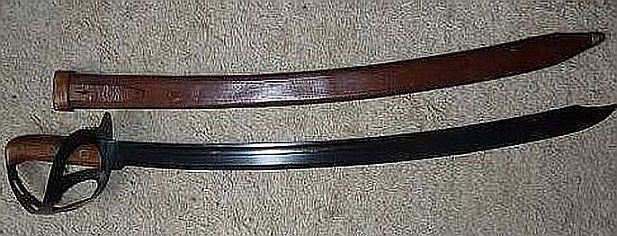
Two photographs illustrate the Netherlands-Dutch Klewang model M1898 from which the U.S. Navy's M1917 cutlass was patterned after. Note the similarities and the differences. Closed cup vs. open cup on the respective hilts. Both have wooden grips with the sweeping falchion blade with clipped tip.
Click Here for further indepth Photographic Documentation, Technical characteristcs and Pricing and Availability for the Dutch Klewang Naval Cutlass

Above photograph shows the "ubiquitous" U.S. Navy M1941 Naval Cutlass produced by Milsco (Milwaukee Saddlery Company). Notice how the cup is open like the Dutch-made Klewang, but the blade is essentially just like the U.S. Navy M1917 cutlass as well as the Dutch M1898. Milsco and another U.S. company called Vince both produced blades and complete cutlasses for the Dutch government just prior to WWII, up until when the Netherlands was occupied by the Germans in 1941.
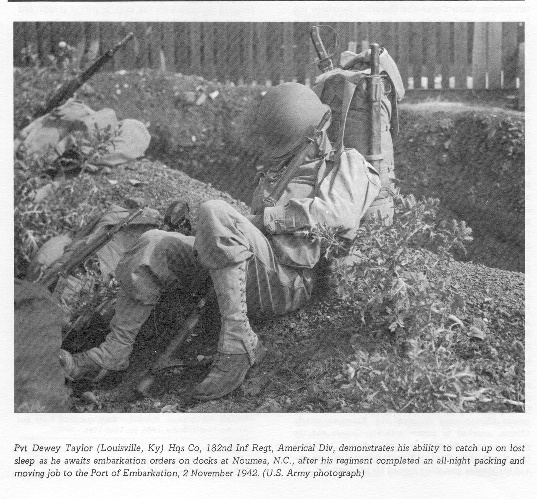
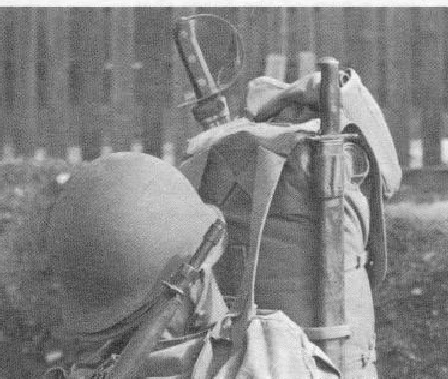
Above two photographs Illustrate a US Soldier of the 182nd Infantry on the Embarcation Docks of Noumea, New Caledonia. Note the Dutch East Indies M1898 Klewang Cutlass packed in the side rear of his ruck sack! 100% documented photographic evidence that the M1898 Klewang was used by US Infantry in the Pacific during WWII. Most likely this was a Japanese captured Klewang who themselves captured it from the Dutch East Indies Army.
Credits to Life Magazine.
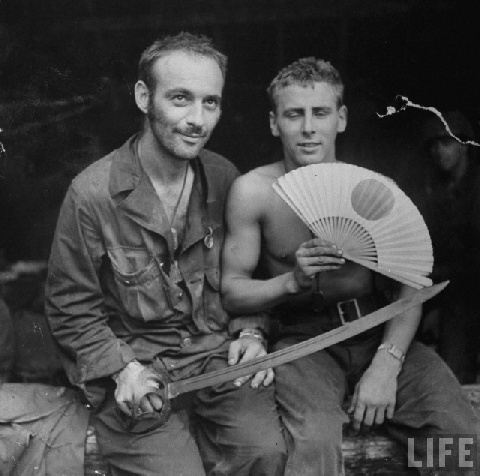
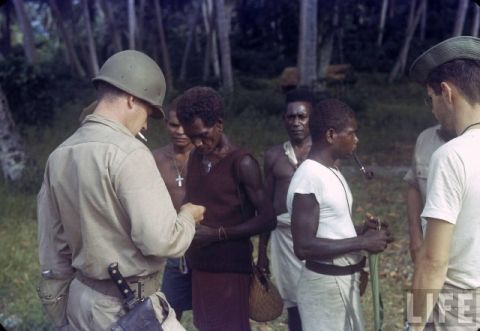 Photograph to the left shows two US Marines (or Army) in the Pacific Theater in Papua, New Guinea 1943 with an M1898 Klewang Cutlass of Netherlands design and manufacture. This Klewang was most likely captured by the Americans from the Japanese, who in turn had captured it from the Dutch or Nederlands Naval Infantry stationed in the Dutch or Netherland East Indies during WWII before their capture.
This particular Klewang Cutlass M1898 was another example of definite Netherlands/Dutch Manufacture due to the rounded apertures seen in the open cup.
Photograph to the left shows two US Marines (or Army) in the Pacific Theater in Papua, New Guinea 1943 with an M1898 Klewang Cutlass of Netherlands design and manufacture. This Klewang was most likely captured by the Americans from the Japanese, who in turn had captured it from the Dutch or Nederlands Naval Infantry stationed in the Dutch or Netherland East Indies during WWII before their capture.
This particular Klewang Cutlass M1898 was another example of definite Netherlands/Dutch Manufacture due to the rounded apertures seen in the open cup.
The Klewang in the photograph to the right appears to be an M1941 version due to the shiny black bakelite grip as opposed to the wooden grip found on the M1898 Klewang. It also appears that the basket hilt has been removed from this cutlass potentially making it a "Klewang Heiho".
(The later M1941 version of the Klewang was actually produced in the thousands by Milsco, (a US manufacturer and earlier another US company called Vince who only supplied blades to the Dutch government), for the Netherlands government just prior to its capture by the Germans at the onset of WWII. This "American" version of Klewang, also known as the M1941, was differentiated from the Netherlands-produced Klewang because it had notches in the open cups of the hilt and with a shiny black bakelite grip. When the Dutch/Netherlands Government defaulted on payment this US company sold the remainder of its production to the US Navy. It is unclear whether the US Navy issued these M1941 Klewangs, but after the war the government sold them as Navy surplus.)
It should be noted that most Klewangs used in the Pacific by Netherlands and Dutch forces when captured by the Japanese were then modified by them by cutting off the steel hilt and cup so that they were used more like a machete to cut down jungle vegetation.
Photograph on right illustrates a Model M1941 Klewang naval cutlass of U.S. manufacture, and is shown being worn in the web belt of a US soldier or Marine in the Pacific Theater. This particular M1941 Klewang "Heiho" cutlass was most likely cut down by the Japanese and is shown being worn in the web belt behind a .45 caliber pistol of a US Soldier or Marine during WWII in the Pacific Theater.
This particular Klewang is definitely a model M1941 due to the black bakelite grip. This U.S. soldier most likely captured it from the Japanese as the black pouch that is attached to his web belt on top of the Klewang is a Japanese cartridge pouch!
We now have photographic evidence of US Soldiers and Marines carrying the M1898 and M1941 Klewang and Klewang Heiho cutlass in the Pacific Theater!
Credits to both photographs go to Life Magazine.


The above two photographs show the U.S. Navy's M1917 Naval Cutlass, the last cutlass to have been formally designated as part of the Navy's inventory of personal sidearms and weapons.
The last official US Naval Cutlass was designated the M1917 and was to replace the now-aging M1860. Ironically, as the M1860, the M1917 US Navy Cutlass was not a pure US Navy design but was modeled after the Netherlands Dutch Klewang M1898 cutlass. The difference being that the Klewang had an open cup while the M1917 had a closed cup similar to the M1860.
M1917 History: The US Navy first contacted the Ames Corporation to manufacture this new naval cutlass but Ames declined the offer to do so. So the US Navy ended up manufacturing the M1917 cutlass itself out of the New York Navy Yard. There are many unknowns about the M1917: how many were actually made, who actually manufactured them, did the Navy get the pieces and assemble them at the New York and Boston Navy Yards, were they actually deployed, where and on what ships.
It is unclear exactly how many of these were made by the Navy, or who made them. This was a production project which was made entirely by the Navy alone and there are not many records or documentation remaining about this fantastic cutlass. The ONLY marking on the M1917 US Navy Cutlass are the initials "USN" on the reverse ricasso of the blade. Oddly, the initials USN were stamped the opposite of all sword and cutlass manufacturer's and certainly much larger than normal.
While some say (including The Pirate's Lair) that the M1917 was the last cutlass made for and approved by the U.S. Navy, some say this is not entirely true. While the Navy never let out a contract, approved, nor provided technical specifications for the production of any cutlass after the M1917 the Milsco-produced cutlass did find its way into the Navy's inventory.
The U.S. Navy purchased many of these M1941 Milsco-produced cutlasses when the Dutch/Netherlands government fell to the Germans during WWII. And at the end of the war the U.S. Navy did have in its inventory thousands of these weapons and sold them as naval surplus, with many finding their way back to the Netherland East Indies during the post-WWII colonial uprisings.
Click Here for further more indepth Technical Characteritics and Information on the US Navy's ca 1800 "Baltimore Pattern" Naval Cutlass
Click Here for further Review and more indepth Photo-History, Technical Characteritics, Information, Pricing and Delivery regarding the M1841 Naval Cutlass
Click Here to Review Photographic History, Technical Characteristics and Information, Pricing and Availability Regarding the US Navy's Model M1860 Naval Cutlass
Click Here for indepth Photographic Documentation, Technical characteristcs and Pricing and Availability for the US Navy's model M1917 Naval Cutlass
Click Here For Price, Availability and Technical Information on the French Naval Cutlass Models anIX1801 and M1833.
Click Here to Review additional Photographic History, Technical characteristcs Pricing and Availability for the Dutch or Netherlands M1898, M1911, M1940 and M1941 Klewang Cutlass
Click Here for Historical Uniform and Sword Information and Anecdotal Tales and Sea Stories about the Naval Cutlass from the U.S. Navy's Historical Page. Much of the information provided by The Pirate's Lair is corroberated by the U.S. Navy itself.
Click Here for Complete Listing of All Available American U.S. Navy Naval Cutlasses, Boarding Axes, Boarding Pikes
To properly document and offer the true naval cutlass (or the mispelled navel cutlass) we have come to the conclusion that we also need to document and discuss the many fakes and reproductions found out in the markeplace, and bring them to the light of day.
If one is intending to purchase a reproduction piece we find no fault in that, and as long as the reproduction is clearly identified and sold as such then we have no issues with that. We only find issue or fault in sellers who try to offer these fakes and reproductions as true antiques when they clearly are not. So it is our intent to post photographs and textual explanations whenever we find a new fake or reproduction cutlass out in the marketplace.
| A Study in FAKE and REPRODUCTION for the US Navy M1860 Naval Cutlass - Warning! Beware of Fakes! Whenever we come across new fakes or reproductions we will post them here! |

Click Photo! |
Photographic examples and written text will illustrate and compare both the fakes to the antique originals. |
Call 540 659 6209 |
Below are links to other Antique Nautical and Naval Artifacts which you may be interested in.
Click HERE for WWII US Navy Anchor China, Matching Dinnerware for the Anchor Navy Silverware
Click HERE for Nautical Antique Trunks Which Look Like Captains Sea Chests, Treasure Chests, Pirate Chests - Great to Re-Use as a Navy Retirement Shadowbox and Storage for Uniforms and Memorabilia
Authentic 100+ Year Old Nautical Antique Trunks
The Real Deal! Fully Restored Antique Trunks Like Sea Chests, Pirate Chests, Treasure Chests - Perfect as a Naval Retirement Gift, use as a Shadowbox and to store Uniforms and Service Memorabilia! |
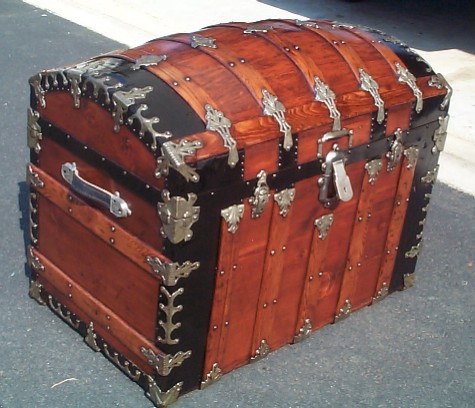
Click Here To Review Sample Engravings |
The Largest Selection of Antique Trunks on the Net to Choose From! |
OPTIONAL - Trunk Wood Engraving Examples and Prices
Custom Designed, Handcrafted, and Hand Lettered in Caligraphy on your Antique Chest |
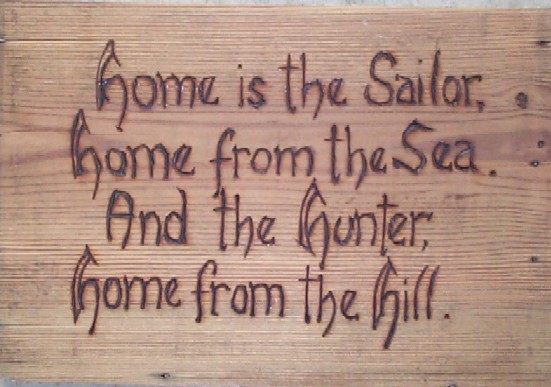
Click Here To Review Sample Engravings |
Personalize Your 100+ Year Old Antique Trunk in Perpetuity! |
Antique Trunks as a Shadow Box and Storage Chest!
Customer Photographic Examples of our Antique Trunks Being used as a Military or Naval Retirement Shadow Box and Storage Chest!! |
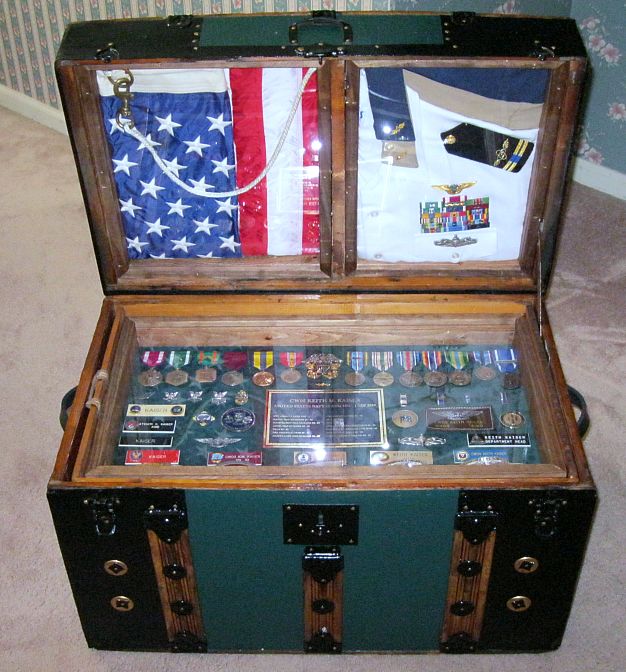
Click Here for Sample Shadow Box Photographs From Customers |
Why just get a shadow box or a newly made trunk with no history! One of our 100+ Year Old Nautical Antique Trunks can be used for both a Shadow Box and Storage Chest for your Uniforms, Photograph Albums, and Memorabilia! |
The Pirate's Lair
Division of DataCity, Inc.
78 Canterbury Drive
Stafford, Virginia 22554
Phone: 540-659-6209
Click Here and Return to The Pirate's Lair Home Page www.thepirateslair.com for more products and company policy information.
"Service Disabled Veteran Owned Small Business"
Or
Email the-pirate@thepirateslair.com


 Or Click HERE to return to The Pirate's Lair Home Page and Gangplank!
Or Click HERE to return to The Pirate's Lair Home Page and Gangplank!
Copyright(c) 2008 All Rights Reserved - Unauthorized downloading, copying or use of any html code, text or images found on this or on any other pages within the www.pirateslair.com website will be prosecuted.
Music Credits: Donald Where's Your Trousers/Drunken Sailor medley by The Bards
ANY TEXT BELOW THIS LINE IS SOLEY FOR THE BENEFIT OF SEARCH BOTS, SPYDERS AND OTHER DENIZENS OF THE DEEP DARK SEA INTERNET
Sometimes the word Naval is mispelled Navel Cutlass! These Antique Naval Swords and Naval Cutlass were the workhorse and personal edged weapon of choice by the US Navy and Merchant Marine throughout the mid to late 19th Century and early to mid 20th Century. These Antique Nautical weapons were multi-purpose
The naval sword or naval cutlass was a mainstay sea service weapon for all navies for over 1000 years until the advent of gunpowder began to make them obsolete as a personal defensive or offensive weapon.







































 Click Here For Expanded Photographic View
Click Here For Expanded Photographic View








 Photograph to the left shows two US Marines (or Army) in the Pacific Theater in Papua, New Guinea 1943 with an M1898 Klewang Cutlass of Netherlands design and manufacture. This Klewang was most likely captured by the Americans from the Japanese, who in turn had captured it from the Dutch or Nederlands Naval Infantry stationed in the Dutch or Netherland East Indies during WWII before their capture.
This particular Klewang Cutlass M1898 was another example of definite Netherlands/Dutch Manufacture due to the rounded apertures seen in the open cup.
Photograph to the left shows two US Marines (or Army) in the Pacific Theater in Papua, New Guinea 1943 with an M1898 Klewang Cutlass of Netherlands design and manufacture. This Klewang was most likely captured by the Americans from the Japanese, who in turn had captured it from the Dutch or Nederlands Naval Infantry stationed in the Dutch or Netherland East Indies during WWII before their capture.
This particular Klewang Cutlass M1898 was another example of definite Netherlands/Dutch Manufacture due to the rounded apertures seen in the open cup.





